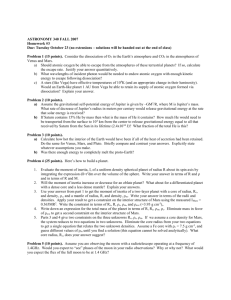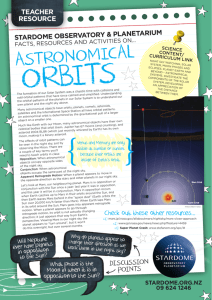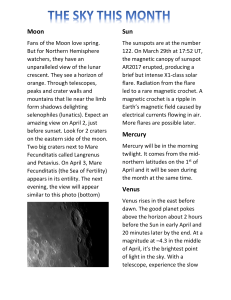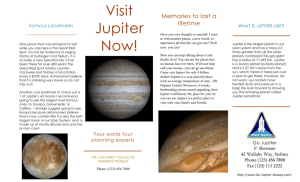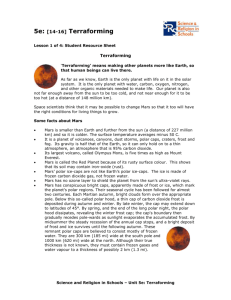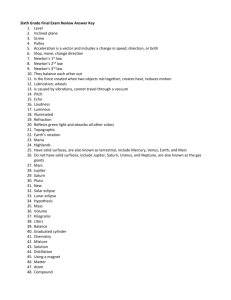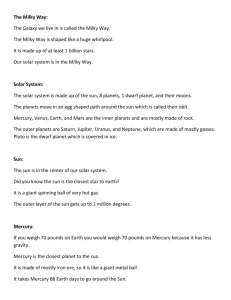friends of the planetarium newsletter - june 2010
advertisement
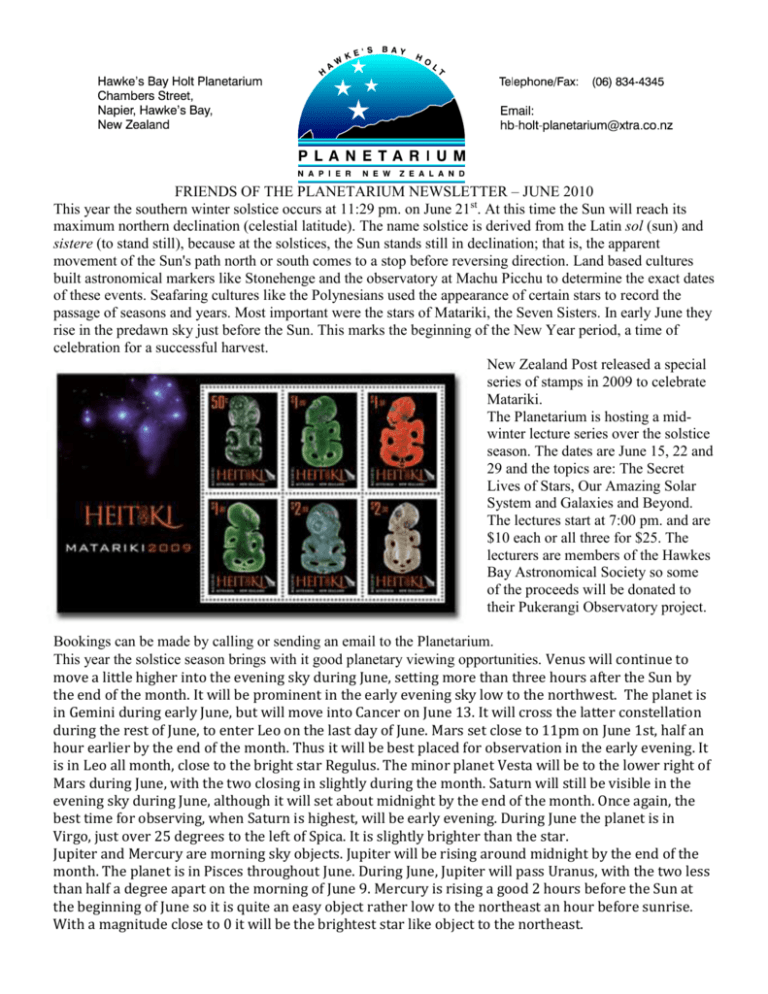
FRIENDS OF THE PLANETARIUM NEWSLETTER – JUNE 2010 This year the southern winter solstice occurs at 11:29 pm. on June 21st. At this time the Sun will reach its maximum northern declination (celestial latitude). The name solstice is derived from the Latin sol (sun) and sistere (to stand still), because at the solstices, the Sun stands still in declination; that is, the apparent movement of the Sun's path north or south comes to a stop before reversing direction. Land based cultures built astronomical markers like Stonehenge and the observatory at Machu Picchu to determine the exact dates of these events. Seafaring cultures like the Polynesians used the appearance of certain stars to record the passage of seasons and years. Most important were the stars of Matariki, the Seven Sisters. In early June they rise in the predawn sky just before the Sun. This marks the beginning of the New Year period, a time of celebration for a successful harvest. New Zealand Post released a special series of stamps in 2009 to celebrate Matariki. The Planetarium is hosting a midwinter lecture series over the solstice season. The dates are June 15, 22 and 29 and the topics are: The Secret Lives of Stars, Our Amazing Solar System and Galaxies and Beyond. The lectures start at 7:00 pm. and are $10 each or all three for $25. The lecturers are members of the Hawkes Bay Astronomical Society so some of the proceeds will be donated to their Pukerangi Observatory project. Bookings can be made by calling or sending an email to the Planetarium. This year the solstice season brings with it good planetary viewing opportunities. Venus will continue to move a little higher into the evening sky during June, setting more than three hours after the Sun by the end of the month. It will be prominent in the early evening sky low to the northwest. The planet is in Gemini during early June, but will move into Cancer on June 13. It will cross the latter constellation during the rest of June, to enter Leo on the last day of June. Mars set close to 11pm on June 1st, half an hour earlier by the end of the month. Thus it will be best placed for observation in the early evening. It is in Leo all month, close to the bright star Regulus. The minor planet Vesta will be to the lower right of Mars during June, with the two closing in slightly during the month. Saturn will still be visible in the evening sky during June, although it will set about midnight by the end of the month. Once again, the best time for observing, when Saturn is highest, will be early evening. During June the planet is in Virgo, just over 25 degrees to the left of Spica. It is slightly brighter than the star. Jupiter and Mercury are morning sky objects. Jupiter will be rising around midnight by the end of the month. The planet is in Pisces throughout June. During June, Jupiter will pass Uranus, with the two less than half a degree apart on the morning of June 9. Mercury is rising a good 2 hours before the Sun at the beginning of June so it is quite an easy object rather low to the northeast an hour before sunrise. With a magnitude close to 0 it will be the brightest star like object to the northeast. As our exploration of the Solar System continues, the surprises just keep on coming. In a development that has transformed the appearance of the solar system's largest planet, one of Jupiter's two main cloud belts has completely disappeared. "This is a big event," says planetary scientist Glenn Orton of NASA's Jet Propulsion Lab. "We're monitoring the situation closely and do not yet fully understand what's going on." Known as the South Equatorial Belt (SEB), the brown cloudy band is twice as wide as Earth and more than twenty times as long. The loss of such an enormous "stripe" can be seen with ease halfway across the solar system. "In any size telescope, or even in large binoculars, Jupiter's signature appearance has always included two broad equatorial belts," says amateur astronomer Anthony Wesley of Australia. "I remember as a child seeing them through my small backyard refractor and it was unmistakable. Anyone who turns their telescope on Jupiter at the moment, however, will see a planet with only one belt--a very strange sight." Meanwhile, at Mars, data from NASA's Mars Reconnaissance Orbiter has helped scientists solve a pair of mysteries dating back four decades and provided new information about climate change on the Red Planet. The Shallow Radar, or SHARAD, instrument aboard the Mars Reconnaissance Orbiter revealed subsurface geology, allowing scientists to reconstruct the formation of a large chasm and a series of spiral troughs on the northern ice cap of Mars. The northern ice cap is a stack of ice and dust layers up to three kilometers deep, covering an area about the size of New South Wales. Analyzing radar data on a computer, scientists can peel back the layers like an onion to reveal how the ice cap evolved over time. One of the most distinctive features of the northern ice cap is Chasma Boreale, a canyon about as long as Earth's Grand Canyon but deeper and wider. Other enigmatic features of the ice cap are troughs that spiral outward from the center like a gigantic pinwheel. "Nobody realized that there would be such complex structures in the layers," said Jack Holt, of the University of Texas. "The layers record a history of ice accumulation, erosion and wind transport. From that, we can recover a history of climate that's much more detailed than anybody expected." A membership renewal form is included with this newsletter. Thanks again for your support.

